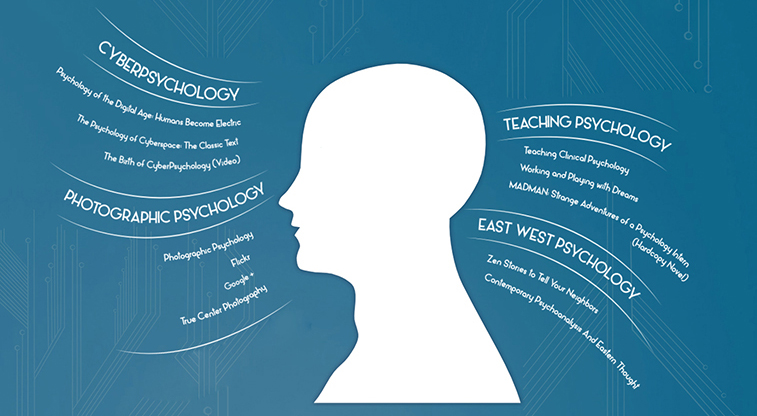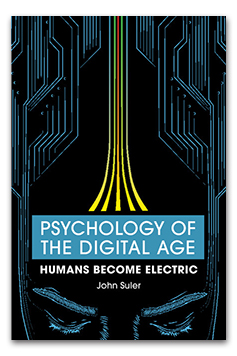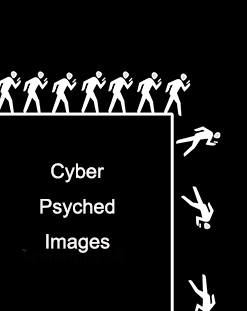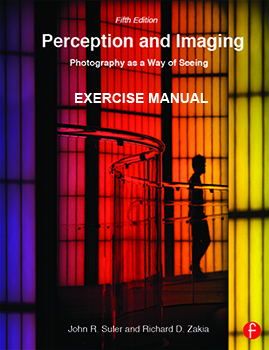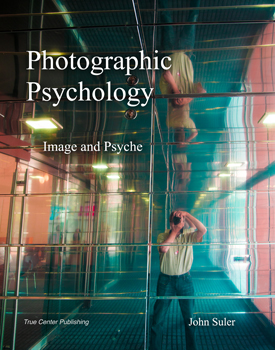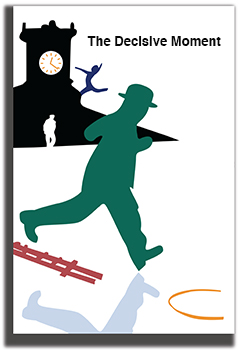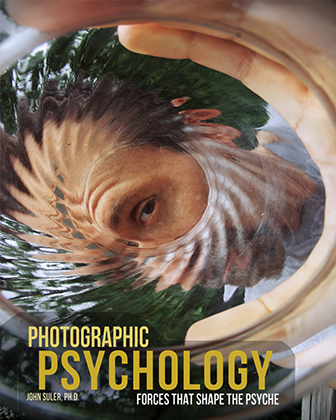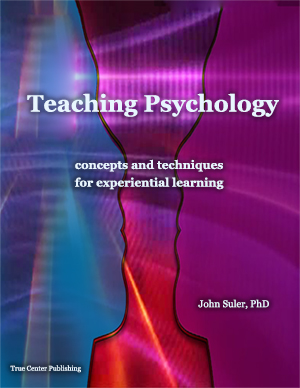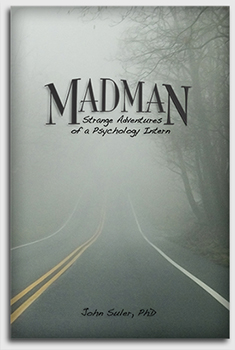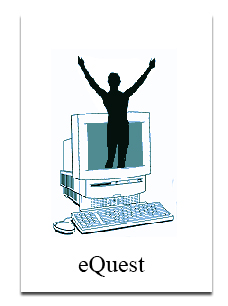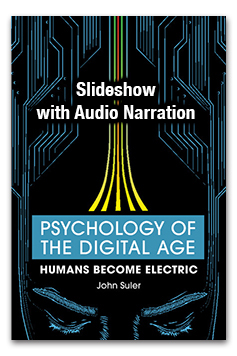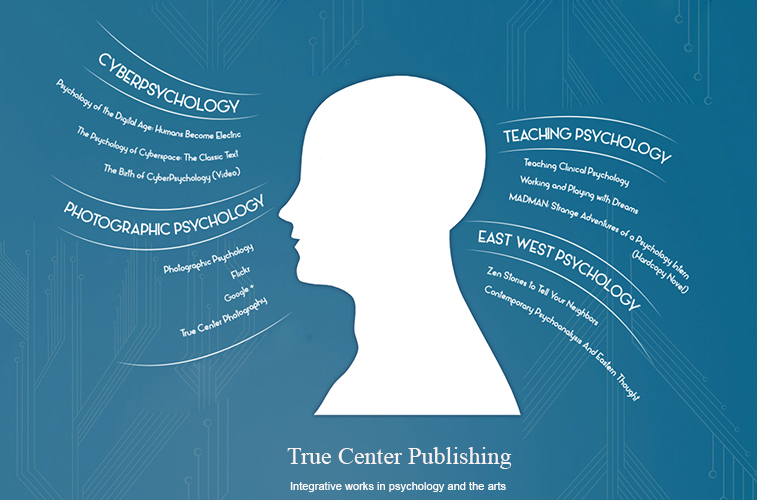Suler, J. (2017). The Dimensions of Cyberpsychology Architecture. Leading chapter in J. Gackenbach (Ed.), Boundaries of Self and Reality Online: Implications of Digitally Constructed Realities, Academic Press (pdf)
Suler, J. (2016). Psychoanalytic cyberpsychology. International Journal of Applied Psychoanalytic Studies, 13(1) (pdf)
Suler, J. (2016). The uncanny in the digital age. International Journal of Applied Psychoanalytic Studies, doi: 10.1002/aps.1479 (pdf)
Suler, J. (2016). The Eight Dimensions of Cyberpsychology Architecture: Overview of a Transdisciplinary Model of Digital Environments and Experiences (pdf)
Suler, J. (2016). Cyberpsychology Architecture. Chapter 1 in Psychology of the Digital Age: Humans Become Electric, Cambridge University Press (pdf)
Suler, J. (2016). The Disinhibited Self. Chapter 4 in Psychology of the Digital Age: Humans Become Electric, Cambridge University Press (pdf)
Suler, J. (2016). Electric Therapeutics. Chapter 15 in Psychology of the Digital Age: Humans Become Electric, Cambridge University Press (pdf)
Suler, J. (2015). The ambivalence of the digital natives. International Journal of Applied Psychoanalytic Studies, 12(2), 175-180 (pdf)
Suler, J. (2011). Interpersonal guidelines for texting. International Journal of Applied Psychoanalytic Studies, 7, 358-361 (pdf)
Suler, J. (2010). Myths about online psychotherapy. Cross Currents: The Journal of Addiction and Mental Health, 13, 3 (pdf)
Suler, J. (2009). The psychotherapeutics of online photosharing. International Journal of Applied Psychoanalytic Studies, 6, 339-344 (pdf)
Suler, J. (2008). Image, action, word: Interpersonal dynamics in a photo-sharing community. CyberPsychology and Behavior, 11, 555-560 (pdf)
Suler, J. (2008). Cybertherapeutic theory and techniques. In Psychological Aspects of Cyberspace: Theory, Research, Applications (A. Barak, editor), pp. 102-128. Cambridge University Press (pdf)
Barak, A., Boniel-Nissim, M., & Suler, J. (2008). Fostering Empowerment in online support groups. Computers in Human Behavior. 24, 1867-1883 (pdf)
Barak, A., & Suler, J. (2008). Reflections on the Psychology and Social Science of Cyberspace. In Psychological Aspects of Cyberspace: Theory, Research, Applications (A. Barak, editor), pp 1-12. Cambridge University Press (pdf)
Suler, J. (2005). eQuest: Case study of a comprehensive online program for self-study and personal growth. CyberPsychology and Behavior, 8, 379-386 (pdf)
Suler, J. (2004). Computer and cyberspace addiction. International Journal of Applied Psychoanalytic Studies, 1, 359-362 (pdf)
Suler, J.R. (2004). The psychology of text relationships. In: Kraus, R., Zack, J., Stricker, G. (eds.), Online counseling: a handbook for mental health professionals, pp 19-50. London: Elsevier Academic Press (pdf)
Suler, J.R. (2004). The online disinhibition effect. CyberPsychology and Behavior, 7, 321-326 (pdf)
Suler, J.R. (2004). In-class and online: Using discussion boards in teaching. CyberPsychology and Behavior 7, 397-403 (pdf)
Fenichel, M., Suler, J., Azy Barak, Zelvin, E., Jones, G., Munro, K., Meunier, V., & Walker- Schmucker, W. (2002). Myths and Realities of Online Clinical Work. CyberPsychology and Behavior, 481-497 (pdf)
Suler, J.R. (2002). The future of online clinical work. Journal of Applied Psychoanalytic Studies, 4, 265-270 (pdf)
Suler, J.R. (2002). Identity Management in Cyberspace. Journal of Applied Psychoanalytic Studies, 4, 455-460 (pdf)
ISMHO Clinical Case Study Group - J. Suler, lead author (2001). Assessing a person's suitability for online therapy. CyberPsychology and Behavior, 4, 675-680 (pdf)
Suler, J.R. (2001). Psychotherapy and clinical work in cyberspace. Journal of Applied Psychoanalytic Studies, 3, 95-97 (pdf)
Suler, J.R. (2001). Online clinical case study and peer supervision groups. Journal of Applied Psychoanalytic Studies, 3 (pdf)
Suler, J.R. (2001). The online clinical case study group: An e-mail model. CyberPsychology and behavior, 4, 711-722 (pdf)
Suler, J.R. (2001). The psychology of avatars and graphical space in multimedia chat communities. In Chat Communication, Michael Beiswenger (Ed.), pp. 305-344. Ibidem, Stuttgart, Germany (pdf)
Suler, J.R. (2000). Psychotherapy in cyberspace: A 5-dimension model of online and computer-mediated psychotherapy. CyberPsychology and Behavior, 3, 151-160 (pdf)
Suler, J.R. (2000). Exploring psychoanalysis on the web. Journal of Applied Psychoanalytic Studies, 2, 205-208 (pdf)
Suler, J.R. (1999) To get what you need: Healthy and pathological Internet use. CyberPsychology and Behavior, 2, 385-394 (pdf)
Suler, J.R. (1999). Internet mailing lists. Journal of Applied Psychoanalytic Studies, 1, 199-201 (pdf)
Suler, J. (1999). Publishing Online. Journal of Applied Psychoanalytic Studies, 1, 373-376 (pdf)
Suler, J.R. (1999). The Palace. New Observations: Cultures of Cyberspace, 120, 10 (pdf)
Suler, J.R. and Phillips, W. (1998). The Bad Boys of Cyberspace: Deviant Behavior in Multimedia Chat Communities. CyberPsychology and Behavior, 1, 275-294 (pdf)
Suler, J.R. (1997). From ASCII to Holodecks: Psychology of an Online Multimedia Community. Presenation at the Convention of the American Psychological Association, Chicago (pdf)
